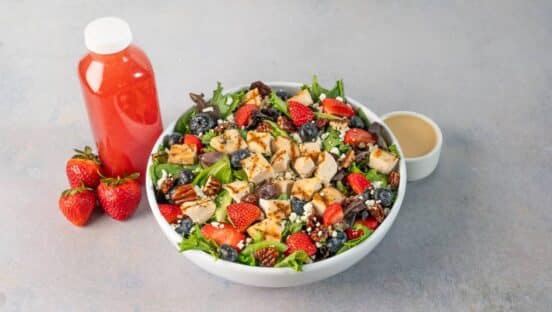Though research and development used to be an old boys’ club in the limited-service industry, the tables are slowly starting to turn.
As quick serves and fast casuals expand their gender horizons both in the C-suite and beyond, more women are leading R&D efforts and bringing their unique viewpoint to the menu-creation process.
“In general, women like to connect with their food,” says Tessa Stamper, director of culinary at Noodles & Company, a fast casual based in Denver that specializes in a varitey of noodle dishes. “We like to connect with a plate; we like to connect with our families.”
In her role at the brand, Stamper sees how food fits into women’s relationships within a family, a perspective that women are able to tap into when creating new dishes, she says.
“Missing out on that aspect of it would be a detriment to the menu-development process, because it’s not just about food and it’s not just about something tasting good,” Stamper says.
Amy Alarcon, vice president of culinary innovation at Popeyes Louisiana Kitchen, says everything in an individual’s background influences his or her approach to developing menu items.
As a mother, she says, she has fine-tuned her ability to multitask both at home and in the workplace, something that has been beneficial to her role at Popeyes.
“I’m constantly dealing with three or four different things at one time,” she says. “And when you’re in a retail product development environment, the pace is very fast.”
Changing direction at a moment’s notice has become second nature for Alarcon, and it’s a helpful skill that allows her to be more nimble when creating new dishes or revamping items that didn’t quite hit the mark during product testing at various Popeyes units.
In addition, as women continue to wield greater control over meal-time purchasing decisions, many limited-service brands are discovering that a female perspective within the R&D department can help them target this increasingly important market segment.
Stephanie Gamble, vice president of brand development at Zaxby’s, says the chicken concept used to focus much of its menu on the male crowd.
In recent years, however, Zaxby’s has shifted its efforts to also hit a chord with women. Before the shift, lighter-fare options such as salads were meager, and Gamble recalls wanting to branch out.
“I said, ‘How can we be more appealing, but not completely alienate guests that love us for who we are and what we are?’” she says. To solve the dilemma, her team examined portion sizes, the variety of greens used in menu offerings, and other menu options to include offerings that women would be eager to purchase and enjoy, too.
Connecting with these female consumers often means touching on what they value in their own kitchens: food that’s fresh, comforting, and feels homemade.
Alarcon says providing busy women with dishes they want to feed their families may be an important factor in attracting more female customers. “We would like to think we can help a busy working mom look really successful when she walks in the door and she’s got a meal that’s going to bring everybody to the dinner table,” she says.
With a background as a dietician, Noodles & Company’s Stamper is acutely aware of the nutritional aspect many women value when putting food on the table.
Aside from healthier and lighter items, she says many female guests are also looking for kid-friendly options. Moms not only want to feed their families food that tastes good and is good for them, but they also seek out dishes that their children will enjoy and can easily eat.
Crafting menu items that meet all of those criteria takes a comprehensive mix of skills and experience. “We have a very large female and family-oriented base,” Stamper says. “We have to appeal to that population and understand their needs.”
Not only do women bring a greater understanding of female customers’ wants and needs, but they also help craft a more diverse R&D team.
“Any environment is incredibly boring when everybody looks the same, sounds the same, and talks the same,” Alarcon says, adding that balance is simply better. “People have their own unique strengths and talents, and you want to build a team that is the sum of the whole.”
By combining the unique perspectives of both men and women, Alarcon says, menu-development efforts are more likely to result in products and choices that truly appeal to consumers. “To me, the best organizations have a little bit of everybody in them,” she says.
Recognizing that men and women each contribute their own strengths—and weaknesses—to a team is important to success, Gamble says. She adds that women often bring what she calls “domestic science” skills to the table, while men frequently have talent in areas such as spatial design.
“When I look at our department and how it’s structured, we have a woman leading product development and a man leading kitchen design,” she says.
The seeds for greater diversity in foodservice R&D are there, but progress unfortunately continues to be slow, and may be for some time to come. While Alarcon says industry barriers are finally coming down, it still isn’t an easy road.
Alarcon, who came to the Popeyes product development team after working for hotels and restaurants, says she has been the only woman in the kitchen on many occasions.
But a more traditional work schedule—rather than the evenings and weekends so often required of chefs—is often one of the factors that attracts women in foodservice to the product-development side of the business.
“That’s one reason it’s so appealing for women to get into this kind of arena,” she says.
“You can exercise your culinary passion but still have somewhat of a normal life.”










